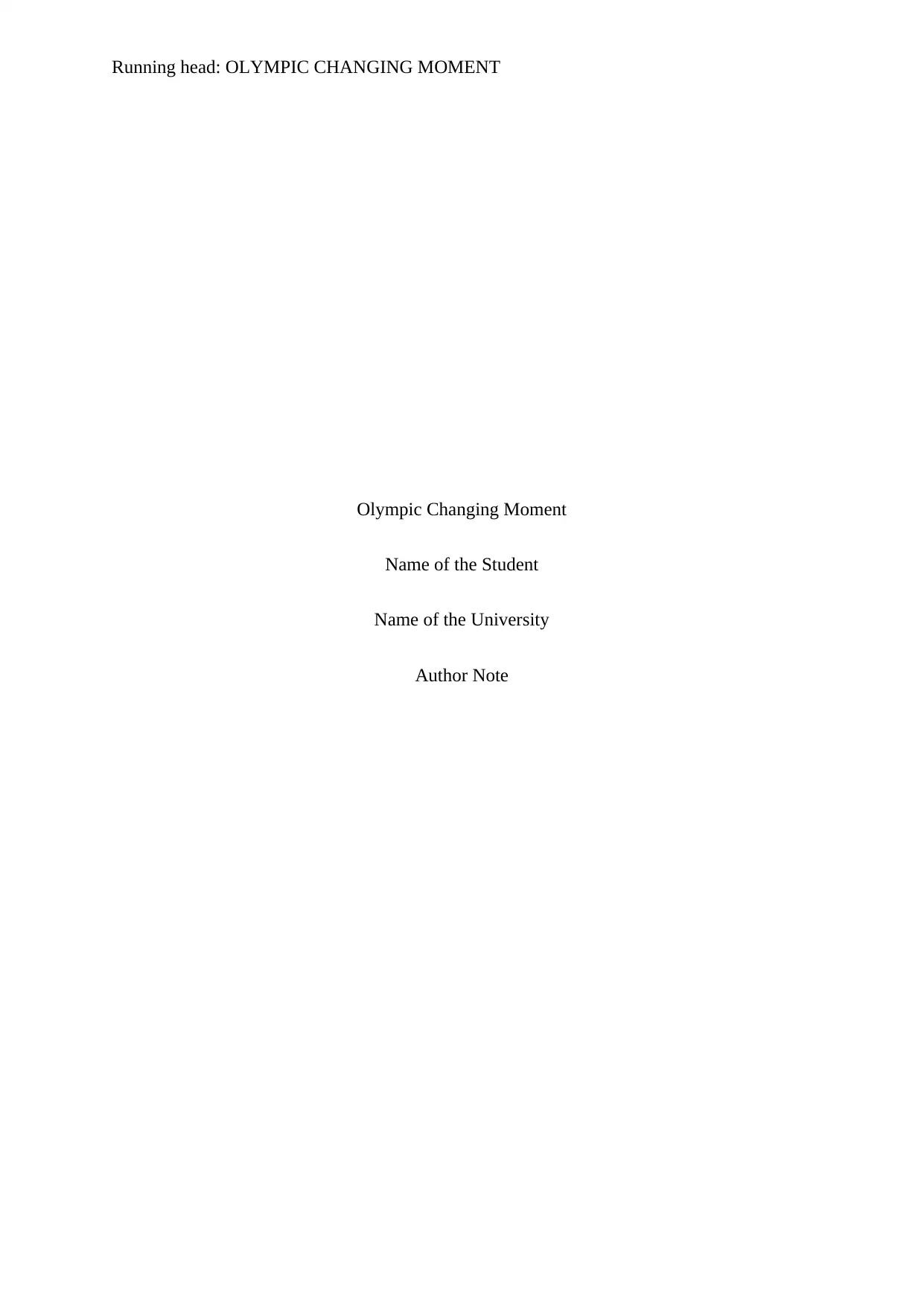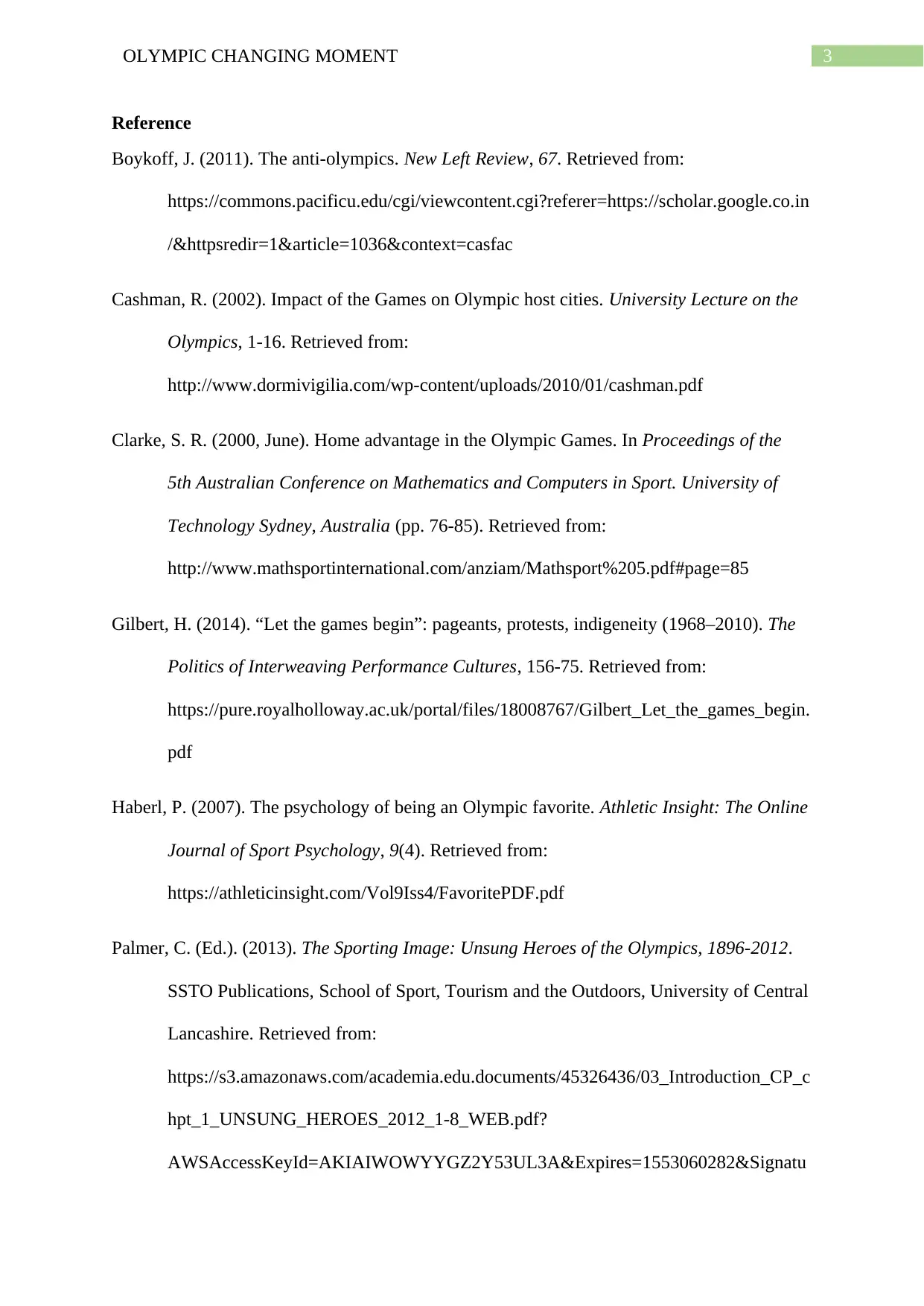Conestoga College: LIBS1100 - Olympic Changing Moment Essay Analysis
VerifiedAdded on 2023/04/08
|5
|892
|392
Essay
AI Summary
This essay delves into a significant Olympic changing moment: the Black Power salute protest at the 1968 Summer Olympics in Mexico City. It examines the socio-political context of the time, including the Vietnam War, civil rights struggles, and student protests, providing the background to the event. The essay focuses on athletes Tommie Smith and John Carlos's actions, their motivations, and the immediate repercussions, including their expulsion from the Games. Furthermore, it analyzes the long-term impact of the protest, including changes in the International Olympic Committee (IOC) policies, the evolution of attitudes towards athlete activism, and the broader influence on social involvement within the Olympic movement. The essay concludes by highlighting the importance of protecting the Olympics as a field for international balance rather than a battleground for ideological disputes.

Running head: OLYMPIC CHANGING MOMENT
Olympic Changing Moment
Name of the Student
Name of the University
Author Note
Olympic Changing Moment
Name of the Student
Name of the University
Author Note
Paraphrase This Document
Need a fresh take? Get an instant paraphrase of this document with our AI Paraphraser

1OLYMPIC CHANGING MOMENT
The modern Olympic Games is the most popular international sporting events in the
world, presenting summer and winter sports competitions where thousands of athletes from
more than 200 nations participate from around the world in a variety of events (Cashman,
2002). There were many controversies in this most coveted sports tournament in the world,
like games boycott, doping by athlete or athletes, not allowing a country to participate in the
games and many more. Our aim will be to find out an Olympic changing moment or issue,
and the purpose will be to investigate the future steps, if any, followed in the Olympics due to
that particular incident.
One such incident happened in the 1968 summer Olympic games (Gilbert, 2014). The
world was in a disturbed state as the War in Vietnam faltered, Martin Luther King and Robert
F. Kennedy has been killed, riots in racism ripped the United States and some more incidents
happened. Taking into account those massive incidents, the world reached Mexico City to
cherish the mega event. Students from Mexico had started demanding democracy throughout
the summer. Just 10 days prior to the opening ceremony of the games, a large number of
students gathered in one of the capital’s central squares, and the government army opened
fire. It created a havoc, as many as 300 rioters were killed and more than 1,000 were injured
(Boykoff, 2011). Czech Republic’s gymnast and loyalist Vera Caslavska, who was hiding
from the time when Soviet Union’s tanks curled into her country to put down the Prague
Spring, risked her autonomy and went on to compete in the games. When Caslavska won a
gold medal with a Soviet gymnast, she clearly curved down her head while the Soviet
national anthem was playing (Palmer, 2013). However, the podium saw arguably the most
memorable Olympic protest of all time – Tommie Smith and John Carlos, two American
athletes, who won gold and bronze medals in the 200 metres respectively, gave a silent and
significant Black Power Salute when the US national anthem ‘The Star-Spangled Banner’
had been played. Both of them were not wearing any shoes, to symbolise black poverty while
The modern Olympic Games is the most popular international sporting events in the
world, presenting summer and winter sports competitions where thousands of athletes from
more than 200 nations participate from around the world in a variety of events (Cashman,
2002). There were many controversies in this most coveted sports tournament in the world,
like games boycott, doping by athlete or athletes, not allowing a country to participate in the
games and many more. Our aim will be to find out an Olympic changing moment or issue,
and the purpose will be to investigate the future steps, if any, followed in the Olympics due to
that particular incident.
One such incident happened in the 1968 summer Olympic games (Gilbert, 2014). The
world was in a disturbed state as the War in Vietnam faltered, Martin Luther King and Robert
F. Kennedy has been killed, riots in racism ripped the United States and some more incidents
happened. Taking into account those massive incidents, the world reached Mexico City to
cherish the mega event. Students from Mexico had started demanding democracy throughout
the summer. Just 10 days prior to the opening ceremony of the games, a large number of
students gathered in one of the capital’s central squares, and the government army opened
fire. It created a havoc, as many as 300 rioters were killed and more than 1,000 were injured
(Boykoff, 2011). Czech Republic’s gymnast and loyalist Vera Caslavska, who was hiding
from the time when Soviet Union’s tanks curled into her country to put down the Prague
Spring, risked her autonomy and went on to compete in the games. When Caslavska won a
gold medal with a Soviet gymnast, she clearly curved down her head while the Soviet
national anthem was playing (Palmer, 2013). However, the podium saw arguably the most
memorable Olympic protest of all time – Tommie Smith and John Carlos, two American
athletes, who won gold and bronze medals in the 200 metres respectively, gave a silent and
significant Black Power Salute when the US national anthem ‘The Star-Spangled Banner’
had been played. Both of them were not wearing any shoes, to symbolise black poverty while

2OLYMPIC CHANGING MOMENT
Smith was wearing a black scarf to show the honour being a black, and Carlos wore a cord of
necklace, for the persons who were executed. They also wore one black glove each on
opposite hands as Carlos had forgotten to wore his pair. Officials of the Olympics reacted
immediately and firmly. Both the athletes had breached the Olympic constitution and were
suspended from the USA team, removed from the games and sent home. On the very next
day, three other African-American runner wore black skullcap when they were collecting
their medals to show support for their expelled teammates.
The games left an impact on social involvement in Olympic Movement. Australian
Peter Norman, who actually softly supported Smith and Carlos, was not sent to the 1972
games though passed the qualification marks a number of times. He was also not included in
the opening ceremony of 2000 Olympic Games hosted by Sydney. Though both Smith and
Carlos became ambassadors for the Olympic Movement and for the peaceful power of sport.
Their gestures actually worked as a catalyst for the changes that can be seen now. It made
people to begin thinking differently about diversity. Taking a lesson from this, the
International Olympic Committee (IOC) took steps so that the same things do not happen in
future games and they had warned the respective teams to take steps so that they could
restrict their athletes from doing these acts. The government also took steps to avoid these
kind of protests in a major event like Olympics, and also took steps to help the oppressed
people. This was a game changer to the modern world. The IOC also told the media to not
distribute such news globally, which may lead to international crisis between nations (Haberl,
2007).
It can be concluded that world-wide attention has been taken by the IOC to avoid such
scenarios. A nation should glory in its individual athletics’ achievements, but a nation should
not use the athletes as tools to ideological battle. The Olympics must be protected as a major
testing field for international balance, not as a minor battleground in international dispute.
Smith was wearing a black scarf to show the honour being a black, and Carlos wore a cord of
necklace, for the persons who were executed. They also wore one black glove each on
opposite hands as Carlos had forgotten to wore his pair. Officials of the Olympics reacted
immediately and firmly. Both the athletes had breached the Olympic constitution and were
suspended from the USA team, removed from the games and sent home. On the very next
day, three other African-American runner wore black skullcap when they were collecting
their medals to show support for their expelled teammates.
The games left an impact on social involvement in Olympic Movement. Australian
Peter Norman, who actually softly supported Smith and Carlos, was not sent to the 1972
games though passed the qualification marks a number of times. He was also not included in
the opening ceremony of 2000 Olympic Games hosted by Sydney. Though both Smith and
Carlos became ambassadors for the Olympic Movement and for the peaceful power of sport.
Their gestures actually worked as a catalyst for the changes that can be seen now. It made
people to begin thinking differently about diversity. Taking a lesson from this, the
International Olympic Committee (IOC) took steps so that the same things do not happen in
future games and they had warned the respective teams to take steps so that they could
restrict their athletes from doing these acts. The government also took steps to avoid these
kind of protests in a major event like Olympics, and also took steps to help the oppressed
people. This was a game changer to the modern world. The IOC also told the media to not
distribute such news globally, which may lead to international crisis between nations (Haberl,
2007).
It can be concluded that world-wide attention has been taken by the IOC to avoid such
scenarios. A nation should glory in its individual athletics’ achievements, but a nation should
not use the athletes as tools to ideological battle. The Olympics must be protected as a major
testing field for international balance, not as a minor battleground in international dispute.
⊘ This is a preview!⊘
Do you want full access?
Subscribe today to unlock all pages.

Trusted by 1+ million students worldwide

3OLYMPIC CHANGING MOMENT
Reference
Boykoff, J. (2011). The anti-olympics. New Left Review, 67. Retrieved from:
https://commons.pacificu.edu/cgi/viewcontent.cgi?referer=https://scholar.google.co.in
/&httpsredir=1&article=1036&context=casfac
Cashman, R. (2002). Impact of the Games on Olympic host cities. University Lecture on the
Olympics, 1-16. Retrieved from:
http://www.dormivigilia.com/wp-content/uploads/2010/01/cashman.pdf
Clarke, S. R. (2000, June). Home advantage in the Olympic Games. In Proceedings of the
5th Australian Conference on Mathematics and Computers in Sport. University of
Technology Sydney, Australia (pp. 76-85). Retrieved from:
http://www.mathsportinternational.com/anziam/Mathsport%205.pdf#page=85
Gilbert, H. (2014). “Let the games begin”: pageants, protests, indigeneity (1968–2010). The
Politics of Interweaving Performance Cultures, 156-75. Retrieved from:
https://pure.royalholloway.ac.uk/portal/files/18008767/Gilbert_Let_the_games_begin.
pdf
Haberl, P. (2007). The psychology of being an Olympic favorite. Athletic Insight: The Online
Journal of Sport Psychology, 9(4). Retrieved from:
https://athleticinsight.com/Vol9Iss4/FavoritePDF.pdf
Palmer, C. (Ed.). (2013). The Sporting Image: Unsung Heroes of the Olympics, 1896-2012.
SSTO Publications, School of Sport, Tourism and the Outdoors, University of Central
Lancashire. Retrieved from:
https://s3.amazonaws.com/academia.edu.documents/45326436/03_Introduction_CP_c
hpt_1_UNSUNG_HEROES_2012_1-8_WEB.pdf?
AWSAccessKeyId=AKIAIWOWYYGZ2Y53UL3A&Expires=1553060282&Signatu
Reference
Boykoff, J. (2011). The anti-olympics. New Left Review, 67. Retrieved from:
https://commons.pacificu.edu/cgi/viewcontent.cgi?referer=https://scholar.google.co.in
/&httpsredir=1&article=1036&context=casfac
Cashman, R. (2002). Impact of the Games on Olympic host cities. University Lecture on the
Olympics, 1-16. Retrieved from:
http://www.dormivigilia.com/wp-content/uploads/2010/01/cashman.pdf
Clarke, S. R. (2000, June). Home advantage in the Olympic Games. In Proceedings of the
5th Australian Conference on Mathematics and Computers in Sport. University of
Technology Sydney, Australia (pp. 76-85). Retrieved from:
http://www.mathsportinternational.com/anziam/Mathsport%205.pdf#page=85
Gilbert, H. (2014). “Let the games begin”: pageants, protests, indigeneity (1968–2010). The
Politics of Interweaving Performance Cultures, 156-75. Retrieved from:
https://pure.royalholloway.ac.uk/portal/files/18008767/Gilbert_Let_the_games_begin.
Haberl, P. (2007). The psychology of being an Olympic favorite. Athletic Insight: The Online
Journal of Sport Psychology, 9(4). Retrieved from:
https://athleticinsight.com/Vol9Iss4/FavoritePDF.pdf
Palmer, C. (Ed.). (2013). The Sporting Image: Unsung Heroes of the Olympics, 1896-2012.
SSTO Publications, School of Sport, Tourism and the Outdoors, University of Central
Lancashire. Retrieved from:
https://s3.amazonaws.com/academia.edu.documents/45326436/03_Introduction_CP_c
hpt_1_UNSUNG_HEROES_2012_1-8_WEB.pdf?
AWSAccessKeyId=AKIAIWOWYYGZ2Y53UL3A&Expires=1553060282&Signatu
Paraphrase This Document
Need a fresh take? Get an instant paraphrase of this document with our AI Paraphraser

4OLYMPIC CHANGING MOMENT
re=IncXCW5nrg7zrd1ZMFZm8vk9HBc%3D&response-content-disposition=inline
%3B%20filename%3DClive_Palmer_2013_Introduction_Beyond_th.pdf
re=IncXCW5nrg7zrd1ZMFZm8vk9HBc%3D&response-content-disposition=inline
%3B%20filename%3DClive_Palmer_2013_Introduction_Beyond_th.pdf
1 out of 5
Related Documents
Your All-in-One AI-Powered Toolkit for Academic Success.
+13062052269
info@desklib.com
Available 24*7 on WhatsApp / Email
![[object Object]](/_next/static/media/star-bottom.7253800d.svg)
Unlock your academic potential
Copyright © 2020–2025 A2Z Services. All Rights Reserved. Developed and managed by ZUCOL.



